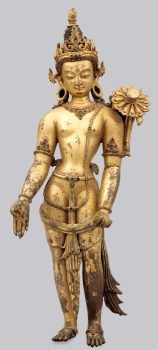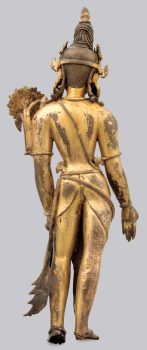Nepal
13th - 14th century
The right hand is extended in a giving gesture.
Nepal
13th - 14th century


The Bodhisattva of Compassion, Avalokiteshvara, is one of the most popular deities in Nepal, where 108 forms of him are known. In his simplest form, extending his right hand in the gesture of giving and holding the stalk of a lotus (now broken) in his left, he is often called Padmapani, or “Lotus-in-Hand.”This sculpture is remarkable for its fluid simplicity of form, graceful proportions, and elegant jewelry. The subtle modeling of the body contrasts with the voluminous pointed dress- and scarf-ends and the large, slim-petaled lotus blossom. The reddish tone of the metal where the gilding has worn away indicates a high copper content, which is typical of Nepalese sculpture.
The cultivation of a strong aspiration to help sentient beings overcome suffering. In Buddhist Mahayana teaching, compassion is the seed for attaining full enlightenment.
Beings who aspire to become fully awakened like the Buddha and are dedicated to helping others on the path to enlightenment.
The Himalayan kingdoms of the Kathmandu Valley were significant centers of Buddhist culture. Nepalese kings, Buddhist institutions, and ordinary people patronized the vibrant art guilds. The artistic traditions of the regions are well-known in Tibetan areas and beyond, and Newar artists have always been in high demand throughout Tibetan regions and Inner Asia.
Get the latest news and stories from the Rubin, plus occasional information on how to support our work.